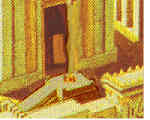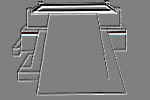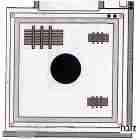This Altar served a variety of uses. The top was used to burn the various sacrifices offered in the Bet Hamikdash.
The walls of the Mizbe'ach were used for the "Zerikat HaDam" (sprinkling the blood of certain sacrifices) as established by the Torah. It was accessed by a series of ramps, built on its southern side.
 The
Altar was made of small stones, lime, pitch, and glazing. The stones
were perfectly smooth, with no nicks or scratches that could be detected
with the thumbnail. These stones were never touched by metal, because
metal is believed to shorten the life of man, and the Altar represents
the lengthening of life.
The
Altar was made of small stones, lime, pitch, and glazing. The stones
were perfectly smooth, with no nicks or scratches that could be detected
with the thumbnail. These stones were never touched by metal, because
metal is believed to shorten the life of man, and the Altar represents
the lengthening of life.The Outer Mizbe'ach consisted of three platforms stacked to form a square pyramid.

To the south of the Mizbe'ach stood a large ramp, which enabled the Kohanim (priests) to ascend to the Altar's roof There were also two smaller ramps, that led to a ledge which surrounded the Altar.
This ledge was called the Sovev - "around" as it was possible to circle the Altar using this ledge. (The additional ledge lower down, did not completely surround the Altar)
 The Red Line
The blood of certain sacrifices was spilled on the upper part of the
Altar's wall. While the blood of the other sacrifices was poured onto
the lower half. To separate the two levels, a red band (Chut Hasikrah in
Hebrew), surrounded the Mizbe'ach at mid-height. To further emphasize
this border, there was a floral design above the red line.
The Red Line
The blood of certain sacrifices was spilled on the upper part of the
Altar's wall. While the blood of the other sacrifices was poured onto
the lower half. To separate the two levels, a red band (Chut Hasikrah in
Hebrew), surrounded the Mizbe'ach at mid-height. To further emphasize
this border, there was a floral design above the red line.On top of the south western corner of the yesod, the base, two drains were carved. The blood remaining from the 'spilling of the blood' service, was poured into these drains.
 Makom Hama'aracha - The Place of Arrangement Three stacks of lumber were arranged on the Altar's platform:
Makom Hama'aracha - The Place of Arrangement Three stacks of lumber were arranged on the Altar's platform:(1) The Large Arrangement - used for burning the animal sacrifices.
(2) Fuel for the burning of the Ketoret, offered twice daily on the small Mizbe'ach (Mizbe'ach Hazahav).
(3) Wood lit by the Kohanim to perform the Mitzvah of igniting the Altar every morning.
In the center of the platform was a large pile of ash that accumulated from the remains of sacrifices. It was called 'the Apple' because of its fruit-like appearance.
The Cornerstones
The Altar had four cornerstones which were hollow and open to the top. Their dimensions were an amah by an amah, and five tefachim high.
There were also two basins built onto the southwestern portion of the platform. They were used on the festival of Succot for the Water Drawing ceremony.
No comments:
Post a Comment